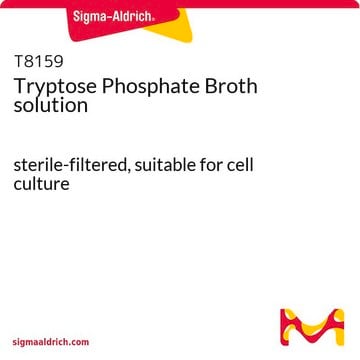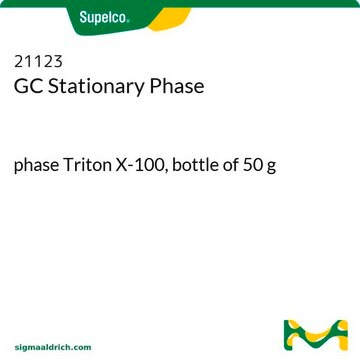Products may be shipped at a different temperature than the recommended long-term storage temperature. If the product quality is sensitive to short-term exposure to conditions other than the recommended long-term storage, it will be shipped on wet or dry-ice. If the product quality is NOT affected by short-term exposure to conditions other than the recommended long-term storage, it will be shipped at ambient temperature. As shipping routes are configured for minimum transit times, shipping at ambient temperature helps control shipping costs for our customers. For more information, please refer to the Storage and Transport Conditions document: https://www.sigmaaldrich.com/deepweb/assets/sigmaaldrich/marketing/global/documents/316/622/storage-transport-conditions-mk.pdf
T8787
Triton™ X-100
for molecular biology
Sinónimos:
t-Octilfenoxipolietoxietanol, Éter polietilenglicol terc-octilfenil
Seleccione un Tamaño
48,60 €
Seleccione un Tamaño
About This Item
48,60 €
Productos recomendados
origen biológico
synthetic (organic)
Nivel de calidad
grado
for molecular biology
descripción
non-ionic
Formulario
liquid
técnicas
protein purification: suitable
protein quantification: suitable
western blot: suitable
impurezas
<1.00% water (Karl Fischer)
pH
9.7
mp
6 °C
temperatura de transición
cloud point 65 °C
pour point ~7 °C
solubilidad
water: 0.1 mL/mL, clear to slightly hazy, colorless to faintly yellow
densidad
1.06 g/mL at 25 °C (lit.)
trazas de catión
Fe: <5 ppm
K: <0.05%
Na: <0.1%
heavy metals: <5 ppm
aplicaciones
hematology
histology
actividad extraña
DNase and RNase, none detected
temp. de almacenamiento
room temp
cadena SMILES
CC(C)(C)CC(C)(C)c1ccc(OCCOCCOCCOCCOCCOCCOCCO)cc1
InChI
1S/C28H50O8/c1-27(2,3)24-28(4,5)25-6-8-26(9-7-25)36-23-22-35-21-20-34-19-18-33-17-16-32-15-14-31-13-12-30-11-10-29/h6-9,29H,10-24H2,1-5H3
Clave InChI
HNLXNOZHXNSSPN-UHFFFAOYSA-N
¿Está buscando productos similares? Visita Guía de comparación de productos
Descripción general
Aplicación
- En inmunohistoquímica para teñir las retinas montadas en plano[3]
- Junto con PBS (disolución salina tamponada con fosfato) enfriada en hielo en suspensión de células para el análisis del ADN celular y el ensayo de la anexina V[4]
- Para permeabilizar las células durante los estudios microscópicos de inmunofluorescencia[5]
- Como control positivo en el ensayo de la LDH para determinar la integridad de la membrana celular[6]
- Para estimar la actividad lipasa en el plasma posheparínico utilizando el procedimiento radioenzimático Belfrage y Vaughan modificado[7]
- Para la preparación de extracto de proteínas de la membrana externa[8]
- Como componente del tampón de extracción junto con tris-HCl, NaCl, CaCl2, ZnCl2, Brij 35 para homogenización de células pulmonares de ratón.[9]
- En el tratamiento de los cortes de tejido para marcaje con inmunofluorescencia[10]
Acciones bioquímicas o fisiológicas
Características y beneficios
- Ideal para aplicaciones sensibles de investigación en biología molecular
- Probado para ADNasas y ARNasas
- Detergente no desnaturalizante no iónico
- Agente humectante y emulsionante superior
- Tensioactivo muy versátil
Otras notas
Información legal
producto comparable
Palabra de señalización
Danger
Frases de peligro
Consejos de prudencia
Clasificaciones de peligro
Acute Tox. 4 Oral - Aquatic Acute 1 - Aquatic Chronic 1 - Eye Dam. 1 - Skin Irrit. 2
Código de clase de almacenamiento
10 - Combustible liquids
Clase de riesgo para el agua (WGK)
WGK 3
Punto de inflamabilidad (°F)
483.8 °F - closed cup
Punto de inflamabilidad (°C)
251 °C - closed cup
Equipo de protección personal
Eyeshields, Faceshields, Gloves, type ABEK (EN14387) respirator filter
Listados normativos
Los listados normativos se proporcionan para los productos químicos principalmente. Para los productos no químicos sólo se puede proporcionar información limitada. Si no hay ninguna entrada, significa que ninguno de los componentes está en la lista. Es obligación del usuario garantizar el uso seguro y legal del producto.
EU REACH SVHC Candidate List
EU REACH Annex XIV (Authorisation List)
Elija entre una de las versiones más recientes:
Certificados de análisis (COA)
¿No ve la versión correcta?
Si necesita una versión concreta, puede buscar un certificado específico por el número de lote.
¿Ya tiene este producto?
Encuentre la documentación para los productos que ha comprado recientemente en la Biblioteca de documentos.
Los clientes también vieron
Artículos
Organoid culture products to generate tissue and stem cell derived 3D brain, intestinal, gut, lung and cancer tumor organoid models.
Protocolos
Preparation for biodegradable nanoparticles and their use in transfection protocols .
How to stain organoids? A complete step-by-step protocol for immunofluorescent (IF) and immunocytochemical (ICC) staining of organoid cultures using antibodies
Contenido relacionado
Cell lysis and protein extraction methods overview various techniques, from detergent solubilization to mechanical disruption, supporting research needs.
Los métodos de lisis celular y extracción de proteínas abarcan varias técnicas, desde la solubilización de detergentes hasta la ruptura mecánica, que respaldan las necesidades de investigación.
Three-dimensional (3D) printing of biological tissue is rapidly becoming an integral part of tissue engineering.
-
How is shipping temperature determined? And how is it related to the product storage temperature?
1 respuesta-
¿Le ha resultado útil?
-
-
How can I determine the shelf life / expiration / retest date of this product?
1 respuesta-
If this product has an expiration or retest date, it will be shown on the Certificate of Analysis (COA, CofA). If there is no retest or expiration date listed on the product's COA, we do not have suitable stability data to determine a shelf life. For these products, the only date on the COA will be the release date; a retest, expiration, or use-by-date will not be displayed.
For all products, we recommend handling per defined conditions as printed in our product literature and website product descriptions. We recommend that products should be routinely inspected by customers to ensure they perform as expected.
For products without retest or expiration dates, our standard warranty of 1 year from the date of shipment is applicable.
For more information, please refer to the Product Dating Information document: https://www.sigmaaldrich.com/deepweb/assets/sigmaaldrich/marketing/global/documents/449/386/product-dating-information-mk.pdf¿Le ha resultado útil?
-
-
What is the concentration of Triton X-1000 T8787?
1 respuesta-
This product is considered a neat or pure liquid at 100% active ingredient. The maximum allowable water content is 1%. This value is lot specific and reported on the Certificate of Analysis.
¿Le ha resultado útil?
-
-
Hello, I am wondering how could I find the purity of the Triton X-100 in your products. Your help and advice is appreciated. Kind regards, Soheil
1 respuesta-
This product is 100 % active ingredient. The maximum allowable water content is 1 % for this product.
Please see the link below to review a sample Certificate of Analysis:
https://www.sigmaaldrich.com/certificates/sapfs/PROD/sap/certificate_pdfs/COFA/Q14/T8787-VAR0000267901.pdf¿Le ha resultado útil?
-
-
Can pure Triton X-100 be stored at and remain stable at less than 4C?
1 respuesta-
This product has been subjected, in the pure form, to temperatures at or near the pour point (1 °C) with no degradation. At lower temperatures, the material may become viscous and require gentle warming to ensure homogeneity. In dilute solutions, such as cell lysates or protein samples, Triton X-100 is an excellent freeze/thaw stabilizer.
¿Le ha resultado útil?
-
-
What form is this in?
1 respuesta-
This product is in liquid form at room temperature (melting point is 6 deg C) as listed in the "Properties" section of the product detail page.
¿Le ha resultado útil?
-
Filtros activos
Nuestro equipo de científicos tiene experiencia en todas las áreas de investigación: Ciencias de la vida, Ciencia de los materiales, Síntesis química, Cromatografía, Analítica y muchas otras.
Póngase en contacto con el Servicio técnico








